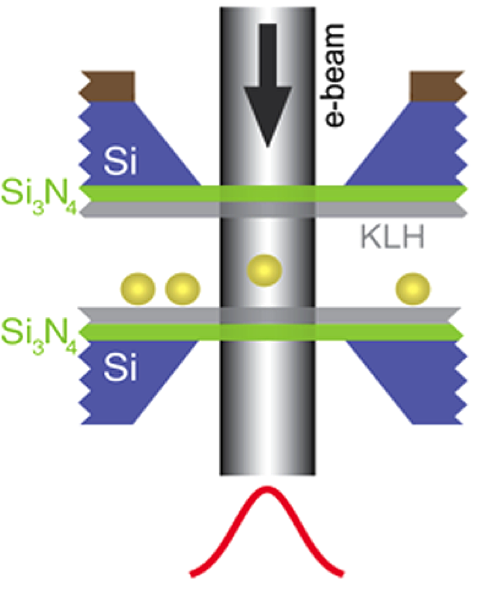Using an electron beam to manipulate nanoparticles
January 16, 2013

How to trap a gold nanoparticle in an environmental cell: an electron beam passes through a silicon nitride window and grabs the nanoparticle (credit: Haimei Zheng et al./Lawrence Berkeley National Laboratory)
Scientists from Berkeley Lab and the National University of Singapore have developed a way to manipulate nanoparticles using an electron beam.
They used an electron beam from a transmission electron microscope to trap gold nanoparticles and direct their movement, and to assemble several nanoparticles into a tight cluster.
They also imaged the nanoparticles as they manipulated them.
Based on their results, the scientists believe their approach could lead to a new way to build nanostructures one nanoparticle at a time.
The research was co-led by Haimei Zheng of Berkeley Lab’s Materials Sciences Division. She and colleagues began by sandwiching a ten-nanometer-diameter particle of gold between two transparent silicon nitride membranes.
This liquid-filled sandwich, called an environmental cell, enables objects to be imaged with a transmission electron microscope at a sub-nanometer resolution. The environmental cell was developed at Berkeley Lab.
They then passed an electron beam through the cell and trapped the nanoparticle in the beam. The nanoparticle bounced to and fro within the beam, but never escaped its confines.

Moving a nanoparticle at will (credit: Haimei Zheng et al./Lawrence Berkeley National Laboratory)
When they moved the beam in any direction at a speed of about ten nanometers per second, the trapped nanoparticle was dragged across the membrane surface.
Next, the scientists trapped several gold nanoparticles inside the beam and corralled them into a tight bunch by rapidly decreasing the diameter of the beam from 200 nanometers to 50 nanometers.
They also moved the cluster of nanoparticles over the membrane surface by moving the electron beam.
Zheng and colleagues are now working to understand how the electron beam traps the nanoparticles. They also want to develop ways to automate the positioning and movement of nanoparticles, which is a key step toward the fast and efficient assembly of nanostructures.
Video (In this video from a transmission electron microscope, an electron beam traps two gold nanoparticles and drags them along.): Electron beam trapping of two gold nanoparticles
Video (An electron beam is used to sweep gold nanoparticles into a cluster, an approach that could lead to a new way to assemble nanostructures.): Electron beam sweeps gold nanoparticles